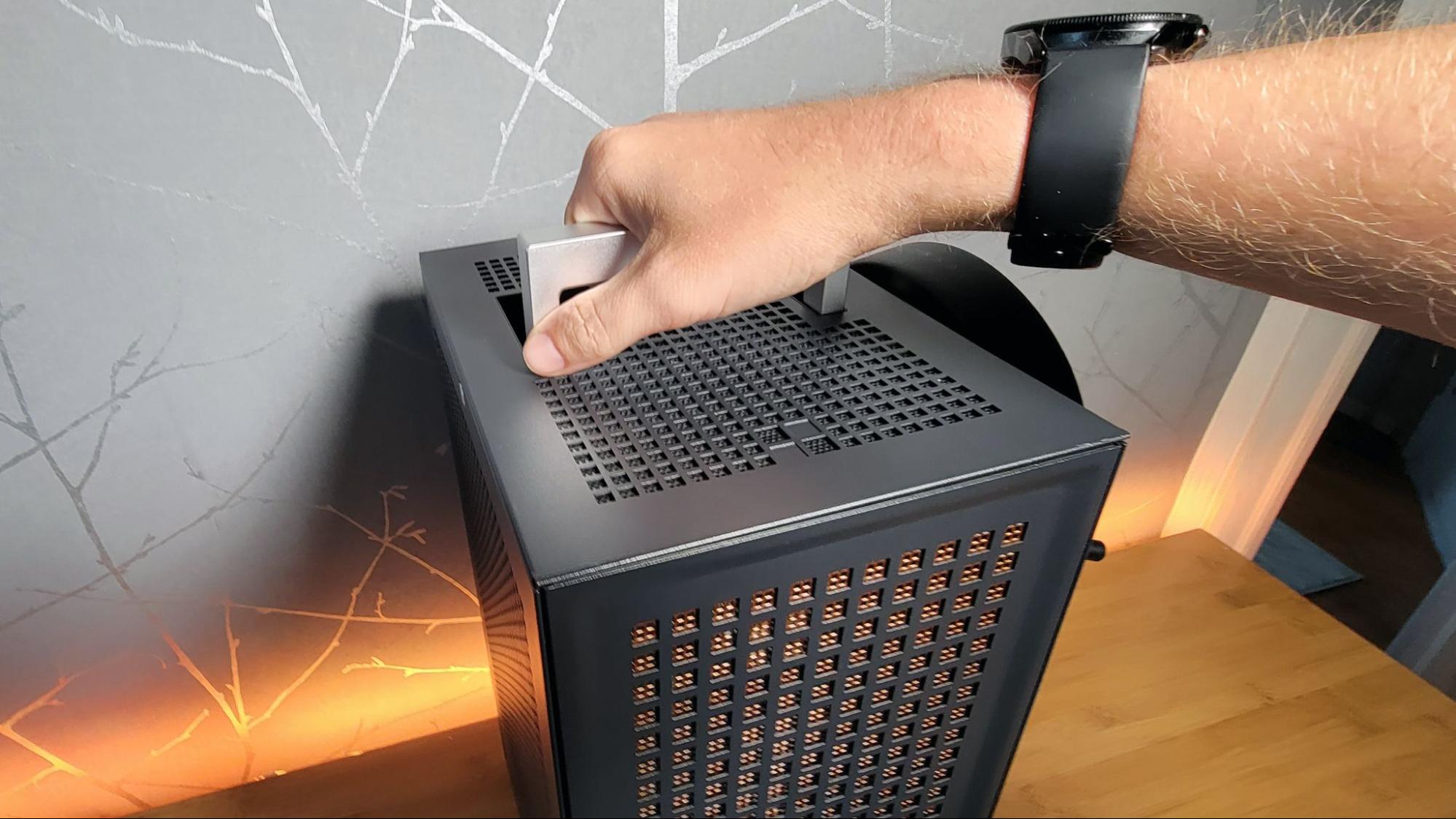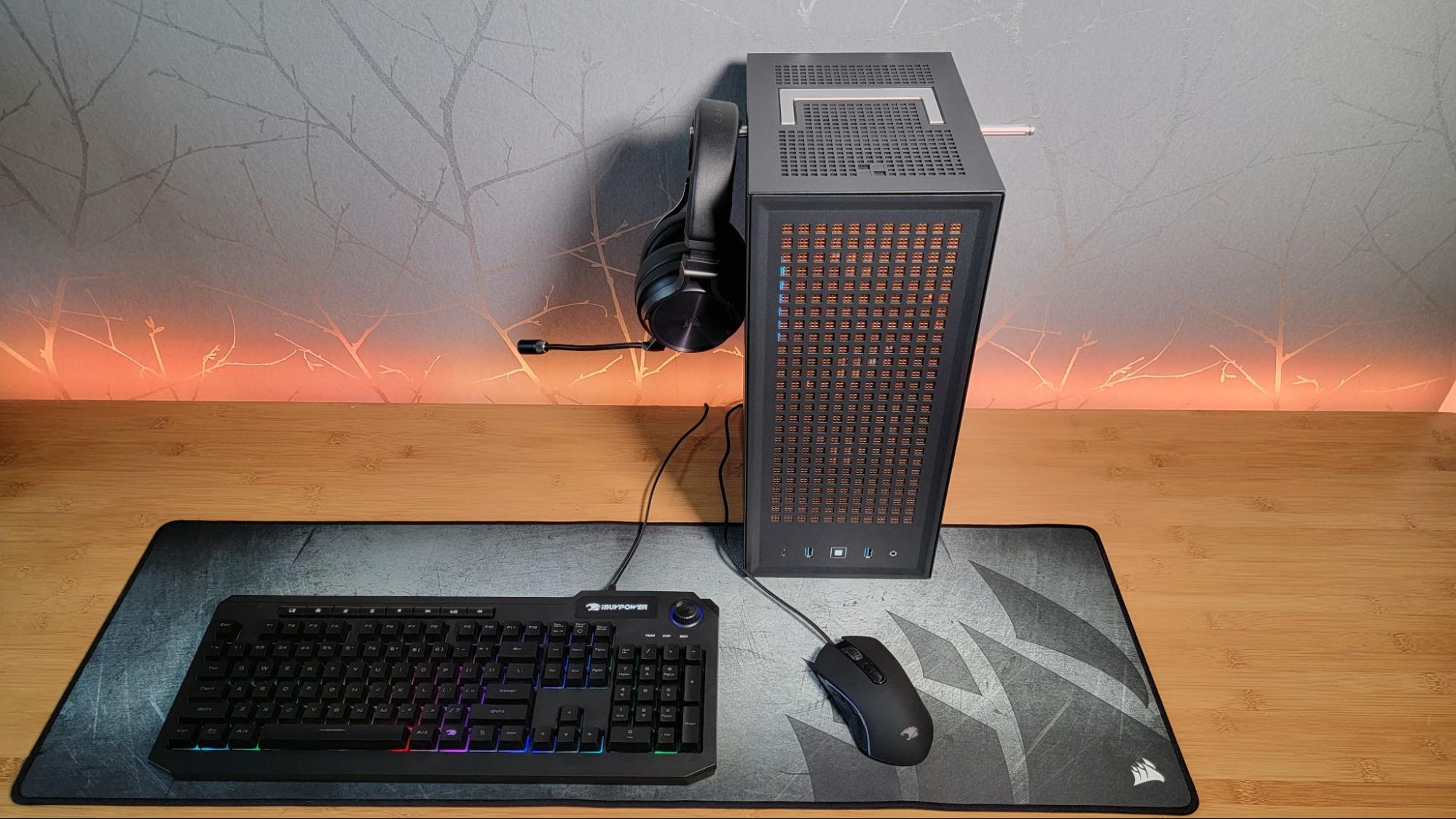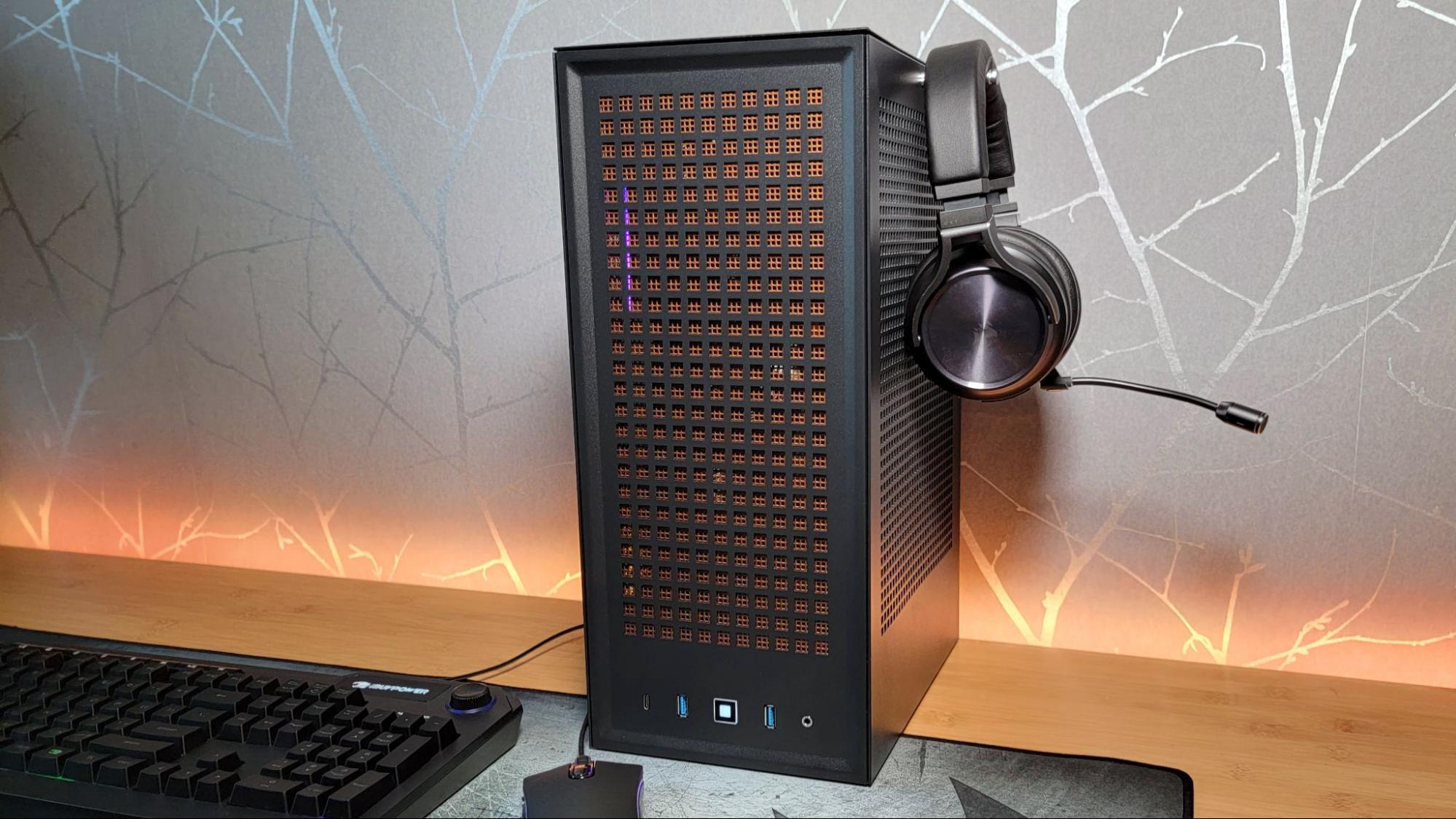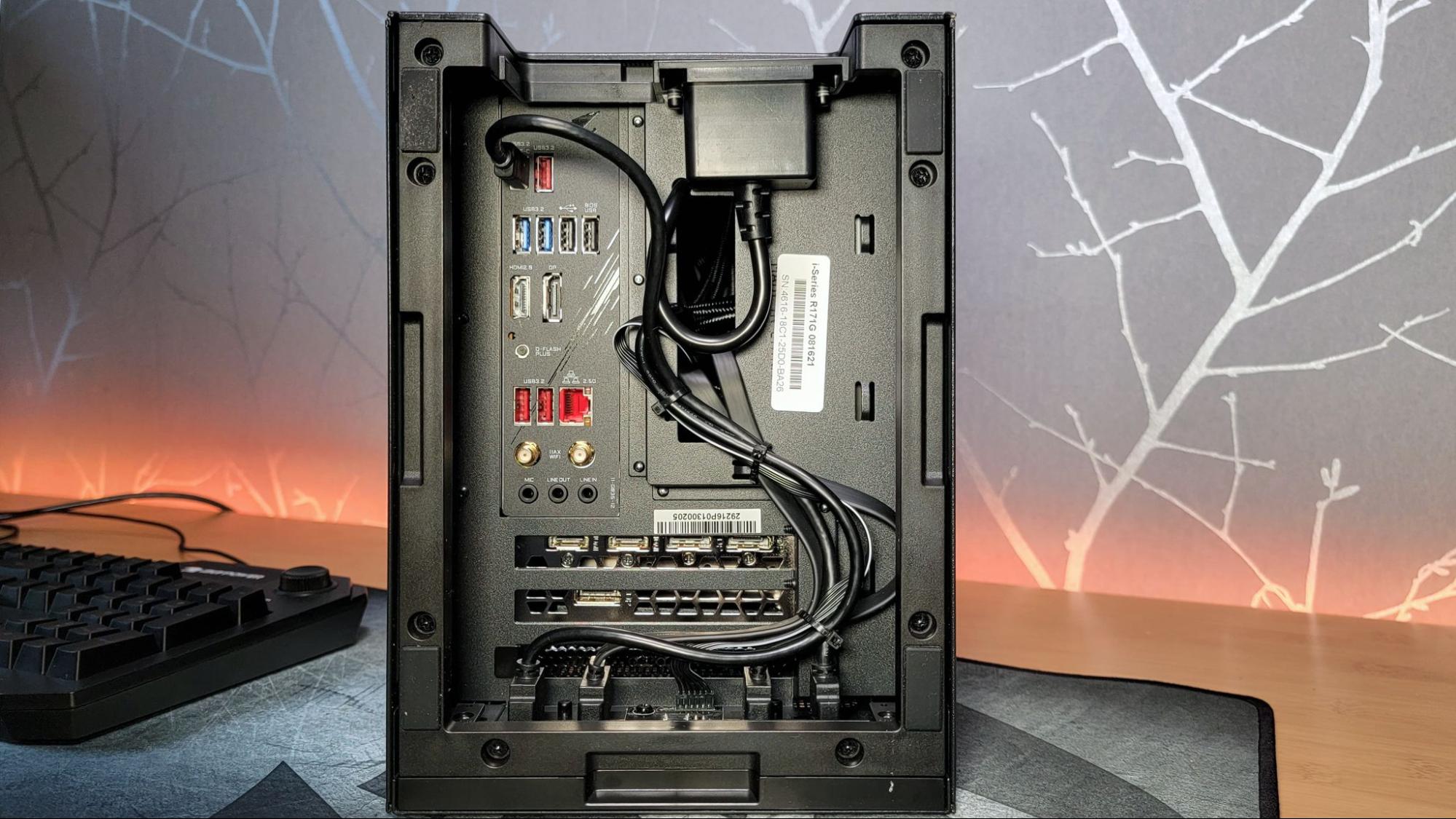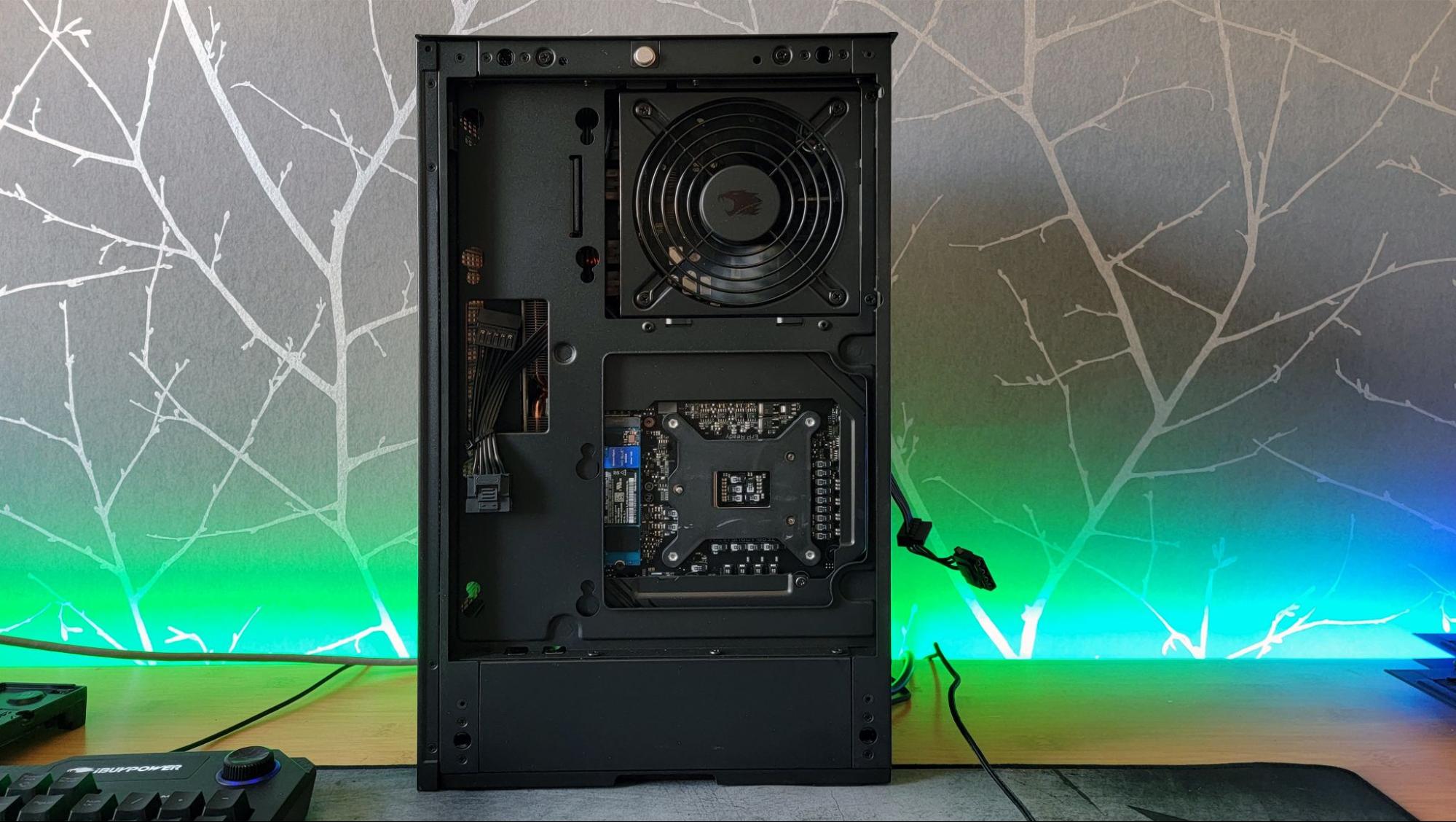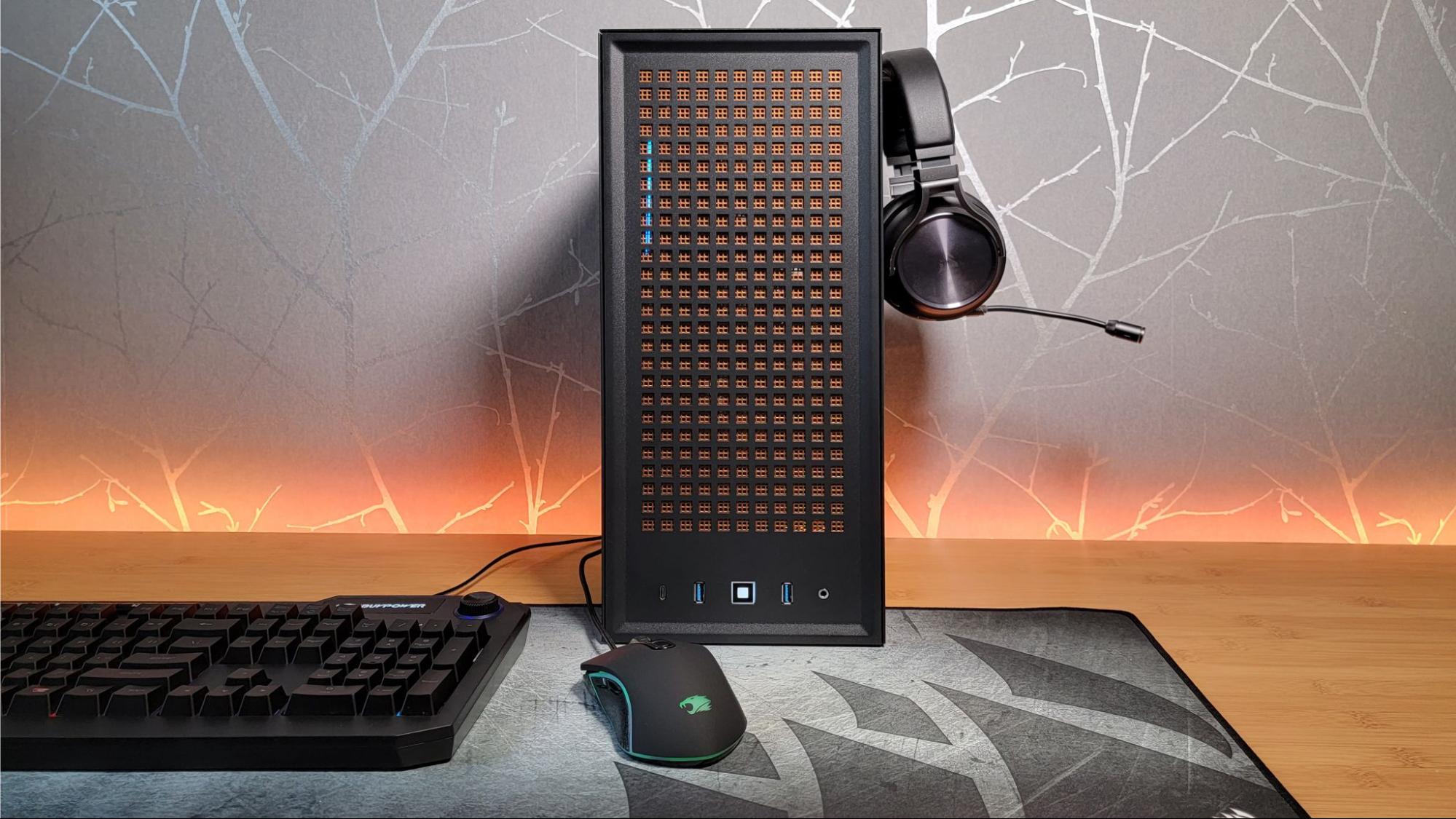Tom's Hardware Verdict
With an excellent handle-equipped case and great performance at a reasonable price, iBuypower's Revolt 3 is a great rig for gamers who want a compact PC they can lug around.
Pros
- +
+ Attractive, understated case
- +
+ Includes a handle and two headset hangers
- +
+ Great performance
Cons
- -
Limited space for upgrades
- -
Bottom-mounted IO complicates peripheral swaps
Why you can trust Tom's Hardware
The Revolt 3 Mini-ITX case first caught our eye when it was announced back in January. Since then, the company has launched the case under a new Hyte brand, our case reviewer gave it a near-perfect score, and it currently occupies a spot on our best pc cases list. Now iBuyPower is offering up the Revolt 3 as a prebuilt (model i7B3) under its own brand name, packed with a Core i7-11700KF CPU and an RTX 3080, priced at $2,599 before any iBuyPower coupons.
With one of the best new cases, a powerful CPU, and a graphics card that occupies the top spot on our best GPU page, what's not to like? The primary concerns come from the system's ITX form factor and compact case (the Revolt 3 stands 16.1 x 7 x 9.9 inches), meaning there isn't a lot of room for internal upgrades — and as tested, there's only 1TB of NVMe storage. Also, the motherboard's ports face the bottom of the case, which makes plugging and unplugging peripherals more difficult (though not that bad on a system this small).
The Revolt 3 even has pop-out pegs on either for hanging your headset, and a built-in handle, both made of sturdy metal. If you're after a semi-portable gaming rig and like clean looks more than a bunch of flashing RGBs, the Revolt 3 is well worth considering. Let's find out if iBuypower's collection of some of the best components earns this PC a spot on our Best Prebuilt PC list as well.
Specifications of the iBuypower Revolt 3
| Processor | Intel Core i7-11700KF | Row 0 - Cell 2 |
| Motherboard | Gigabyte Z590I Aorus Ultra | Row 1 - Cell 2 |
| Memory | 16GB T-Force DDR4-3200 | Row 2 - Cell 2 |
| Graphics | Aorus GeForce RTX 3080 Gaming OC 10G (10GB GDDR6X) | Row 3 - Cell 2 |
| Storage | Western Digital SN550 1TB NVMe M.2 SSD | Row 4 - Cell 2 |
| Networking | Intel Wireless AX200, Bluetooth 5.1 | Row 5 - Cell 2 |
| Front Ports | 1x USB 3.2 Gen 1, 2x USB 3.0, 3.5mm microphone/mic jack | Row 6 - Cell 2 |
| Rear Ports (Motherboard) | 1x USB-C 3.2 Gen 2x2, 3x USB 3.2 Gen 2 Type-A, 2x USB 3.2 Gen 1 Type-A, 2x USB 2.0 Type-A, 3x analogue audio, 2.5Gb Ethernet, 1x DisplayPort, 1x HDMI | Row 7 - Cell 2 |
| Video Output (GPU) | 3x DisplayPort, 1x HDMI | Row 8 - Cell 2 |
| Power Supply | 700W SFX-L | Row 9 - Cell 2 |
| Case | Hyte Revolt 3 | Row 10 - Cell 2 |
| Cooling | 240mm all-in-one CPU liquid cooler with 2x 120mm fans | Row 11 - Cell 2 |
| Operating System | Windows 10 Home | Row 12 - Cell 2 |
| Dimensions | 16.1 x 7 x 9.9 inches (HWD) | Row 13 - Cell 2 |
| Price as Configured | $2,599 | Row 14 - Cell 2 |
Design of the iBuypower Revolt 3
If you're sick of gaming rigs that look like bulky glass rectangles overloaded with RGB lights, you'll likely find the Revolt 3 refreshing. The system comes in white or black, stands 16.1 inches high and occupies just 7 x 9.9 inches of desk space. There are some RGB lights on the system's Aorus GPU and (oddly) the 16GB of RAM that was included in our configuration. But it's not very visible, because the case is all steel panels and black mesh.
Note that the copper-colored front mesh in the images here only ships with a limited number of early orders, which will likely be sold through by the time you read this. But if you like the way it looks, it would be pretty simple to remove the rigid black metal piece and spray paint it any color of your choosing.
The Revolt 3 case (which you can purchase separately under the Hyte Revolt 3 name for a starting price of $129) also has a few interesting added features. An aluminum handle pops up out of the top, making it easier to tote the system wherever you want to take it. And each side has handy spring-loaded pop-out pegs for hanging your headset--or whatever else you might want to hang here.
Much like the Ssupd Meshlicious case we looked at early this year, the steel side and rear panels also pop off with ease, making the Revolt 3 fairly easy to work in or clean.
If you remove a couple of screws on the left side, the 240mm CPU radiator swings out, giving you better access to the internals. Things are tight in here though, which we'll cover a bit more in the next section.
Ports and Upgradeability of the iBuypower Revolt 3
With two USB 3.0 ports and a USB-C port and a headphone/mic combo jack up front, the Revolt 3 is well equipped to let you conveniently plug a few things in. Of course, given that these ports are at the bottom of the case, the system will need to be on your desk for those ports to actually be convenient.
Things get a bit more unorthodox with access to the motherboard ports, though. The case rotates things 90 degrees from normal orientation, putting the rest of the system's ports on the bottom. Yes, that means you'll basically need to tip the system over to plug or unplug anything that doesn't use the front ports. But thanks to the case's compact nature and built-in handle, this isn't quite as annoying as it might seem — though it's definitely less convenient than reaching around the back of your PC. Also note that the bottom ports are recessed about 2.75 inches from the bottom of the case, so you shouldn't have any clearance issues with most cables.
Here, you'll find the ports for the Gigabyte Z590I Aorus Ultra motherboard, including three USB 3.2 Gen 2 Type-A ports, two USB 3.2 Gen 1 ports and two USB 2.0 ports. There's also a USB 3.2 Gen 2x2 Type-C port, but this is occupied by a cable that routes the port to the front of the case.
Ignore the HDMI and DisplayPort on the motherboard, because the Core i7-11700KF CPU lacks a functioning GPU to make any use of them. Instead, you'll plug your monitor(s) into the ports on the Aorus RTX 3080, where you'll find three DisplayPort 1.4a connectors and two HDMI 2.1 ports.
Overall, port selection is OK, although it is annoying that iBuypower sacrificed the sole motherboard USB-C port for the front connector, rather than connecting it to an internal header. The motherboard here has a USB 3.2 Gen 1 header just waiting to bring additional connectivity.
Get Tom's Hardware's best news and in-depth reviews, straight to your inbox.
As for internal upgrade options, one of the primary negatives of the Revolt 3 in the configuration we tested is that it ships with just 1TB of storage (in the form of a WD SN550 SSD). Any gamer playing modern AAA titles is going to fill that up pretty fast. But the motherboard has an unoccupied M.2 slot for adding another SSD. And the case has mounting points for two more 2.5-inch drives on the right side of the case, as well as a 3.5-inch hard drive up top next to the 700W SFX power supply.
That said, given how space-limited the interior of the case is, you'd need black-belt level cable routing skills (and plenty of patience) to install three extra drives in this thing. As shipped, part of the 3.5-inch bay is already occupied by cable slack from the power supply. My advice if you want more storage is to install a couple extra drives here somewhere, then consider external storage options.
Gaming Performance of the iBuypower Revolt 3
With its Intel Core i7-11700KF CPU and Aorus RTX 3080 graphics, paired with 16GB of T-Force-branded RAM, the Revolt 3 packs some of our favorite current components. Even the 1TB Western Digital SN550 M.2 SSD is one of our best SSD picks (if admittedly in the value category).
To see how iBuypower's compact rig stacks up against the competition, we compared its performance with Corsair's similarly sized One a200 (with an AMD Ryzen 9 5900X and a liquid-cooled RTX 3080), as well as the larger MSI Aegis RS 11th (Core i7-11700K, RTX 3080) in our benchmark tests.
The MSI system is priced $100 less than the Revolt 3 and includes a 2TB hard drive as well as a 1TB (Adata) SSD, while the Corsair a200 also includes a 2TB hard drive, along with twice the RAM, and a liquid-cooled GPU as well as CPU. Corsair's system, though, was a whopping $3,700 as tested. And a Corsair One system as similarly configured to our Revolt 3 as we could get still costs about $800 more than iBuypower's compact PC.

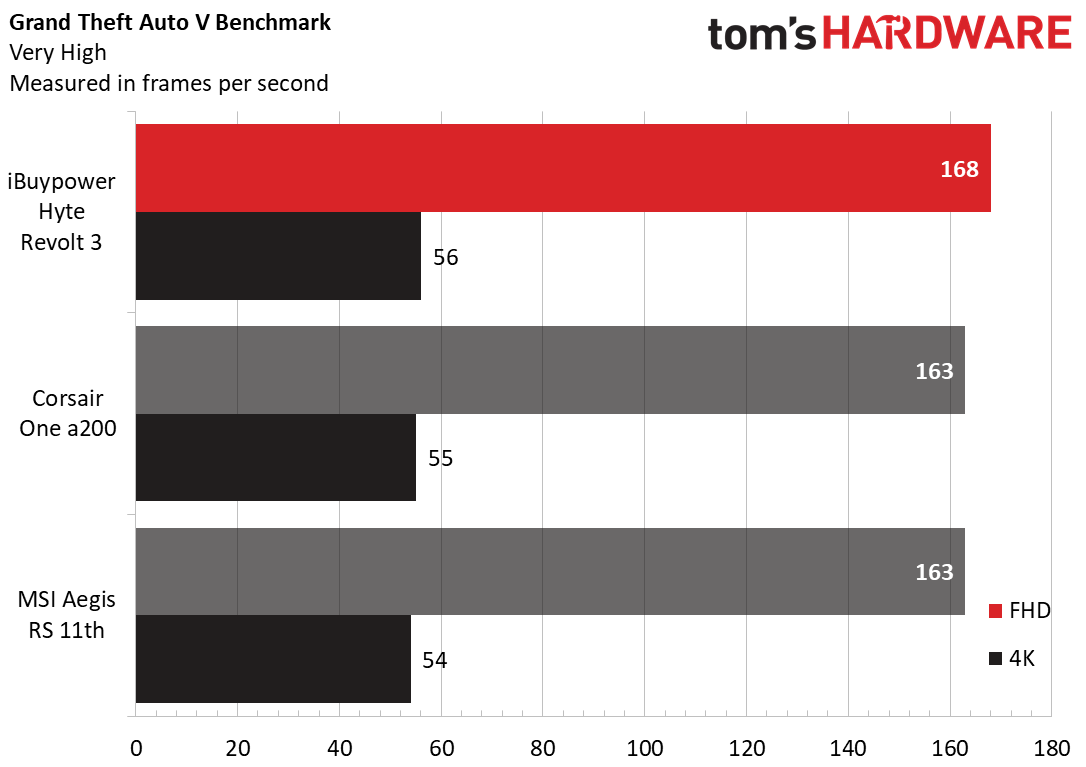
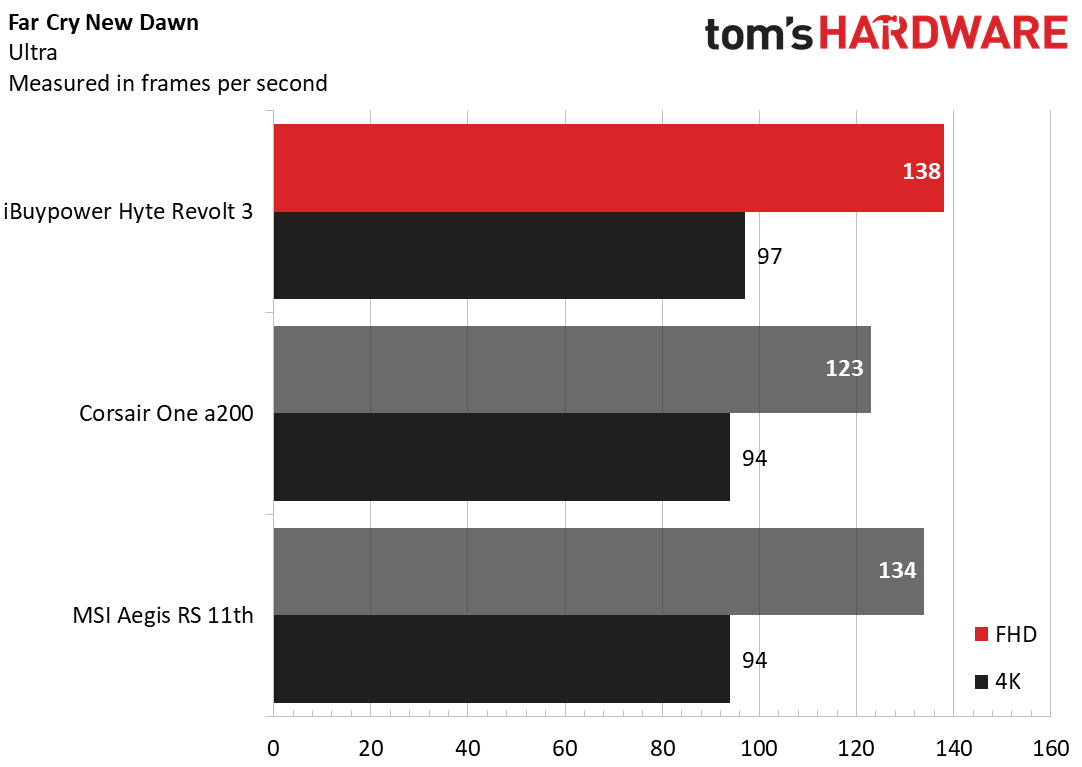
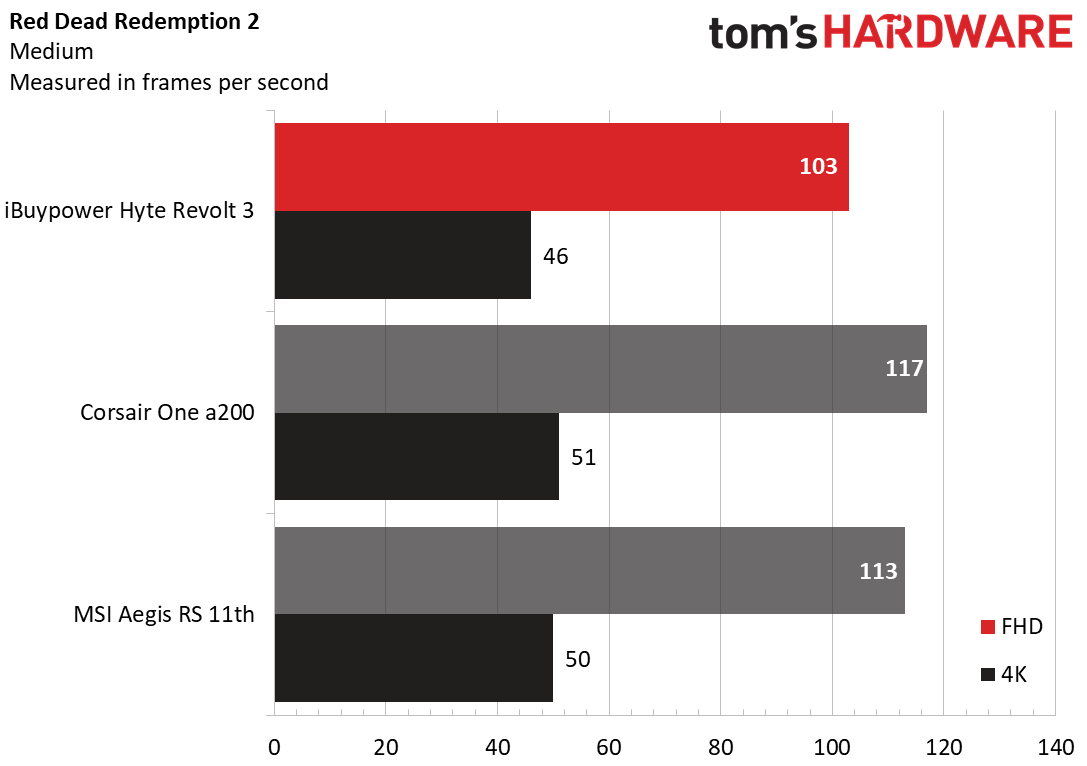
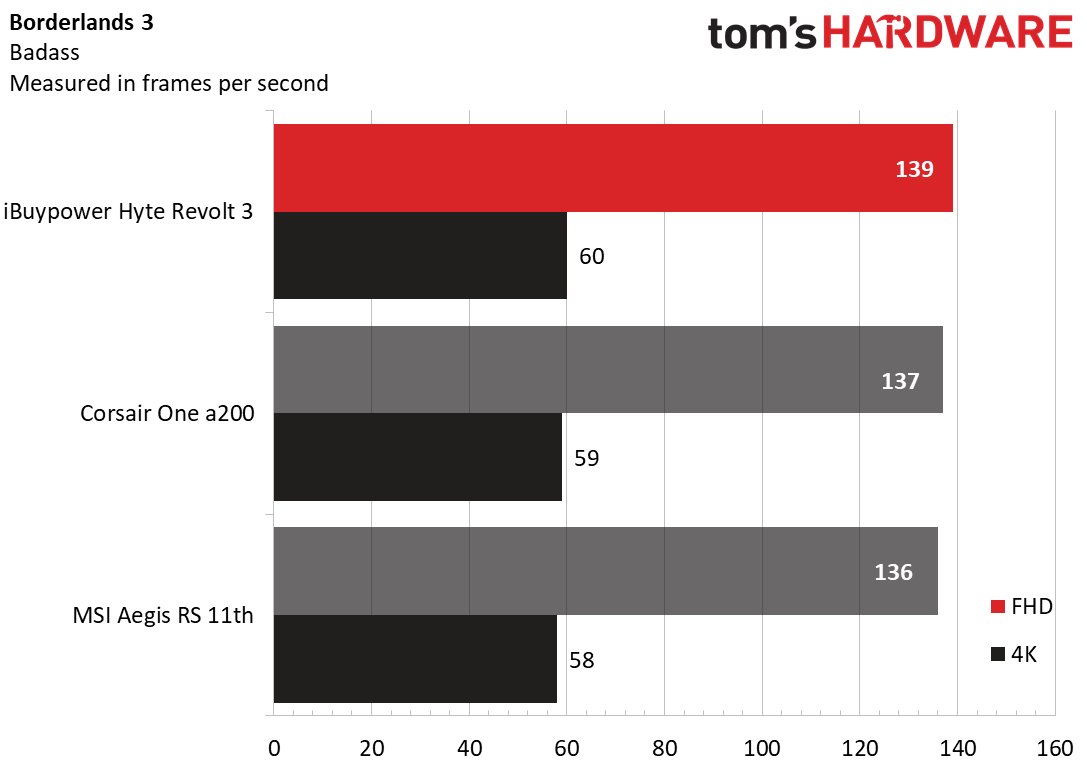
On the Shadow of the Tomb Raider benchmark (highest settings), the Revolt 3 edged out the competition at 1080p, and tied the Corsair at 4K.
In Grand Theft Auto V (very high settings), iBuypower's rig came in first at both resolutions but was only a single frame ahead of the Corsair at 4K.
On the Far Cry New Dawn benchmark, the Revolt 3 was even further ahead of the competition, nearly hitting triple-digit frame rates, even at 4K.
In Red Dead Redemption 2 (medium settings), the iBuypower system looked its worst, trailing both competitors at both resolutions. But it was certainly no slouch, edging above 100 fps at 1080p and running at 46 fps at 4K.
Last up in Borderlands 3 (badass settings), the Revolt 3 was back on top, edging out both other systems at 1080p and 4K. As we'd expect given that all three systems share the same GPU and similar (or at least similarly speedy) CPUs, game performance was close across our testing. But considering the Corsair rig costs much more and sports both a liquid-cooled CPU and GPU and the MSI system is much larger, leaving more room for airflow and fans, the Revolt 3's showing here is quite impressive.
We also subjected the Revolt 3 to our Metro Exodus stress test gauntlet, in which we run the benchmark at the Extreme preset 15 times to simulate roughly half an hour of gaming. The compact tower ran the game at an average of 104.8 fps, and was quite consistent. The system started out the test at 104.7 fps on the first run, and actually went up slightly, peaking at 104.81 on run 6, before settling in at or near 104.8 for the rest of the 15 test runs.
During the Metro Exodus runs, the CPU ran at an average clock speed of 4.43 GHz and an average temperature of 51.8 degrees Celsius (125 degrees Fahrenheit). The GPU’s average clock speed was 1,770 MHz, with an average temperature of 66.1 degrees Celsius (151 degrees Fahrenheit).
Productivity Performance of the iBuypower Revolt 3
The Core i7-11700KF didn't earn a spot on our best gaming CPUs list, but that's primarily due to its price when purchased on its own. With eight cores and 16 threads and a top stock clock speed of 5 GHz, the 11700KF is an excellent performer. And with that chip paired with 16GB of T-Force RAM running at 3200 MHz, the Revolt 3 is also an excellent productivity tower. That said, the Corsair One a200's 12-core Ryzen 9 5900X is very tough competition in highly threaded tests.



On Geekbench 5, an overall performance benchmark, the Revolt 3 pulled ahead of the competition on the single-core side, but lagged behind the Corsair and its 12-core CPU on the multi-core test by close to 20%.
We saw similar results in our Handbrake video transcoding test, where Corsair One a200 crunched our 4K video to 1080p in an impressive 4 minutes and 44 seconds, while the other two systems took 5 minutes and 19 seconds to complete the same task.
Our 25GB file transfer test is where perhaps the Revolt 3 had its worst showing. The system's WD Blue SN550 SSD is a good drive, but on the budget side of the NVMe spectrum. Its tested speed of 784 MBps was good enough to easily beat the MSI machine's 635 MBps. But the Corsair rig has a much faster drive that delivered a speed of over 1,270 MBps. Still, for most common tasks, including games, this speed difference isn't going to be noticeable.
Software and Warranty for the iBuypower Revolt 3
The Revolt 3 ships free of any bloatware (or at least any that doesn't come pre-packaged with the OS). Aside from the Windows 10 (and likely soon Windows 11) OS, you get the Aorus software for controlling the motherboard settings and features, plus Realtek's audio software.
As for warranty coverage, the Revolt 3 comes with a standard one-year warranty if you buy from Amazon or Newegg. But if you buy directly from iBuypower, the system ships with a longer three-year warranty, though that only covers labor. Parts coverage from iBuypower is still one year from purchase.
Configuration Options for the iBuypower Revolt 3
You can configure the Revolt 3 on iBuypower's site in any number of ways, starting off at around $2,199 with a Core i5 CPU and an RTX 3070 Ti. Our Revolt 3 i7BG review configuration can be bought as a prebuilt system direct from iBuypower (sold out when we wrote this), or from Newegg or Amazon for $2,599. Or if you really like spending money, a $4,199 version (i9BG) is also available that ships with an RTX 3090, a Core i9-11900KF, and oddly the same 16GB of RAM and 1TB SSD. The lesser i7GB model is obviously a far better value if you can find it in stock.
Bottom Line
The Revolt 3 from iBuypower is a refreshingly different, powerful compact tower PC. It foregoes the usual glass panels and RGB everything for a compact case with a small footprint, good cooling (thanks to mesh panels everywhere) and impressive gaming and productivity performance. It also costs a whole lot less than the similarly sized Corsair One a200 — though that system is more visually refined, slightly smaller, and sports liquid cooling for both the graphics card and CPU for quieter operation. But the Revolt 3 is far from noisy itself.
Just know that the Revolt 3's motherboard ports stick out of the bottom of the case, making plugging things in a bit more challenging--or at least different. And the only USB-C port that's available here is the one at the front of the case.
With an understated, innovative case with a pop-out handle and headset hangars, top-notch performance and a reasonable price, there's a whole lot to like with the Revolt 3. We're happy to recommend it for those looking for a powerful compact rig that's less 'glass and glow' and more 'go.'
After a rough start with the Mattel Aquarius as a child, Matt built his first PC in the late 1990s and ventured into mild PC modding in the early 2000s. He’s spent the last 15 years covering emerging technology for Smithsonian, Popular Science, and Consumer Reports, while testing components and PCs for Computer Shopper, PCMag and Digital Trends.
-
punkncat The cooling numbers are very good for a case of that type. Building Mini-ITX in that proximity to high power parts is super hard for a build of this size, even with full mesh cases. So many factors to take into account.Reply
At face value for the price and size this seems like a nice option.
